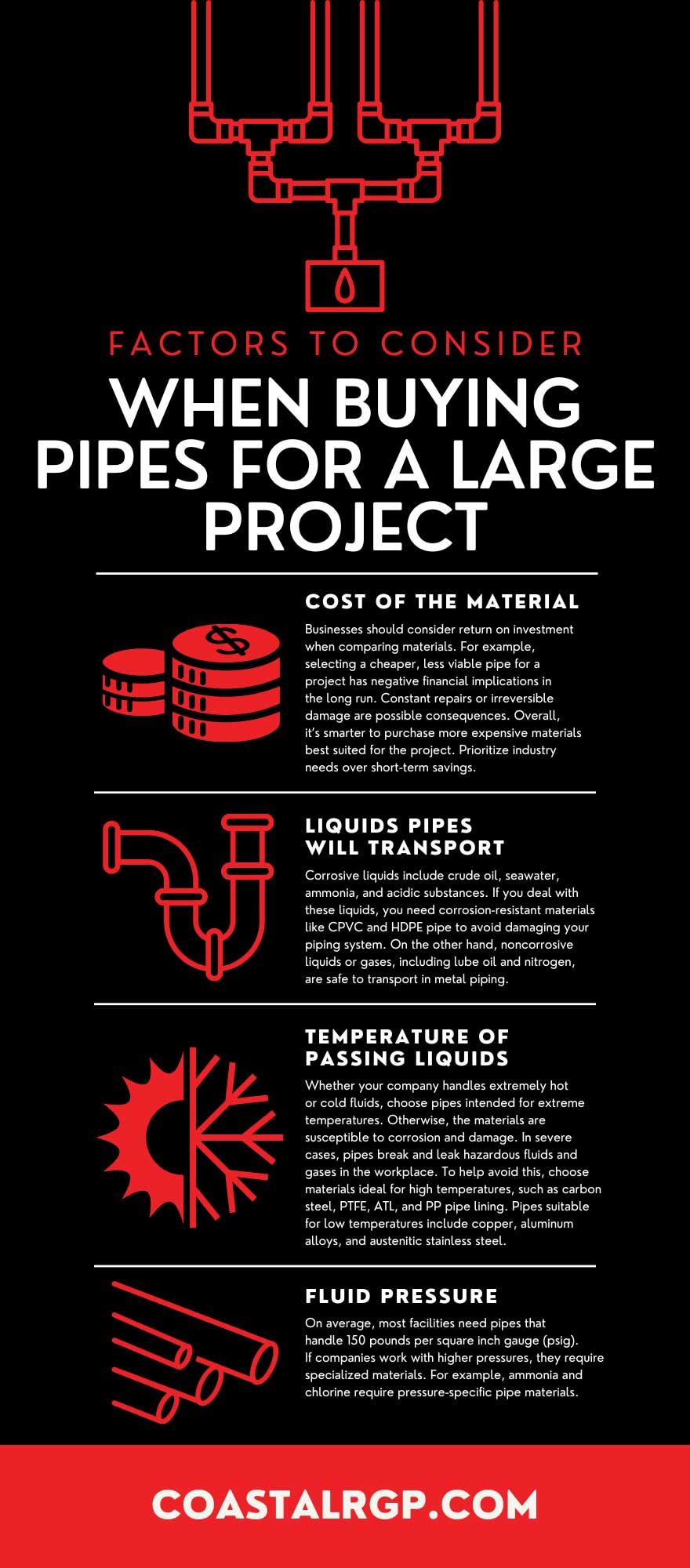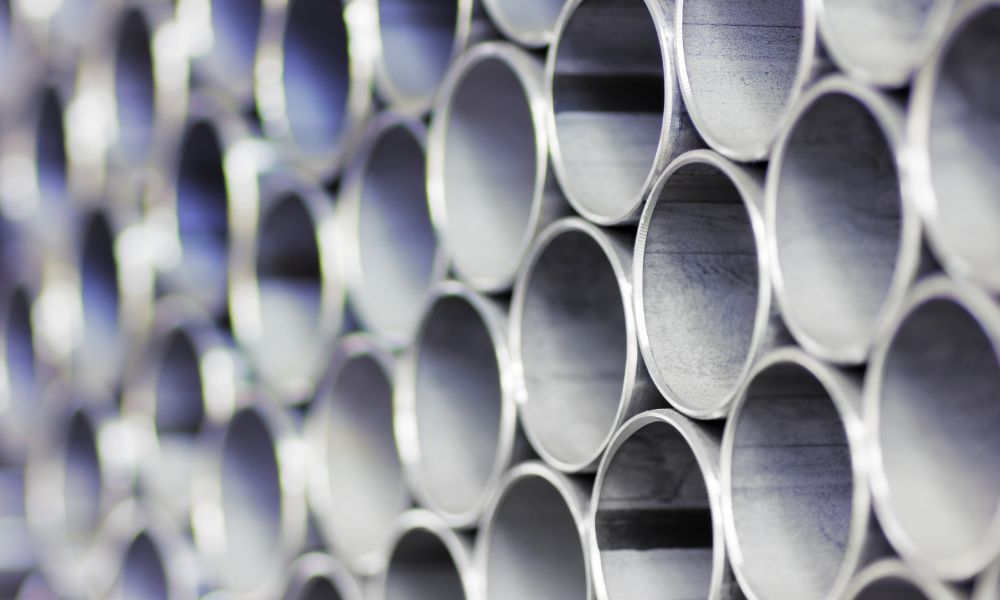A successful project requires the right parts, including reliable pipes. Piping systems run along walls and ceilings to complete various processes. Given their importance, it’s critical to select the best material. Before seeking a supplier, check out these eight factors to consider when buying pipes for a large project.
Cost of the Material
Cost is a significant factor for any business decision, so it’s essential to consider the initial investment. Determine if the pipe material is readily available or if companies must import the pipes and pipe lining materials, along with outsourcing maintenance appointments.
Businesses should also consider return on investment when comparing materials. For example, selecting a cheaper, less viable pipe for a project has negative financial implications in the long run. Constant repairs or irreversible damage are possible consequences. Overall, it’s smarter to purchase more expensive materials best suited for the project. Prioritize industry needs over short-term savings.
Liquids Pipes Will Transport
Assuming specific pipes are suitable for all types of applications is wrong, especially for large projects. Knowing the transported liquids helps companies select the proper fluid-handling pipe materials. So what liquids will your project’s pipes transport? More specifically, will the pipes transport corrosive or noncorrosive liquids?
Corrosive liquids include crude oil, seawater, ammonia, and acidic substances. If you deal with these liquids, you need corrosion-resistant materials like CPVC and HDPE pipe to avoid damaging your piping system. On the other hand, noncorrosive liquids or gases, including lube oil and nitrogen, are safe to transport in metal piping.
Pipe Materials vs. Corrosion
Below are the common pipe materials and how they respond to certain elements.
- Stainless Steel—doesn’t rust or corrode and has a protective oxide layer on the surface. The material is best for pipes handling water, oils, and some chemicals.
- Cast iron—is durable against external corrosives like soil. It can withstand water for short periods, making it suitable for short-term projects.
- HDPE—is corrosion and rust resistant. It is suitable for liquid, solid, and gas applications. HDPE is a leading choice for piping.
- Aluminum alloy—the material doesn’t rust, but it does corrode over time, especially with saltwater or sulfuric substances. It can handle various gases, liquids, and oils.
Temperature of Passing Liquids
Melted pipes are the last thing anyone wants to encounter. When handling high-temperature liquids, choose high-temperature pipe material. For instance, some plastic pipe linings aren’t suitable for high temperatures, whereas others handle all types of liquids. Typically, metal pipes are best for hot liquids, though they’re too hot to touch.
Whether your company handles extremely hot or cold fluids, choose pipes intended for extreme temperatures. Otherwise, the materials are susceptible to corrosion and damage. In severe cases, pipes break and leak hazardous fluids and gases in the workplace. To help avoid this, choose materials ideal for high temperatures, such as carbon steel, PTFE, ATL, and PP pipe lining. Pipes suitable for low temperatures include copper, aluminum alloys, and austenitic stainless steel.
Fluid Pressure
Different liquids and gases create differing pressure inside pipes. If the pressure is high, pipes must be extra strong, high-pressure resistant, or extra thick.
On average, most facilities need pipes that handle 150 pounds per square inch gauge (psig). If companies work with higher pressures, they require specialized materials. For example, ammonia and chlorine require pressure-specific pipe materials.
It’s critical to ask suppliers about pressure requirements because using the wrong pipes can lead to leaks, explosions, flooding, and fires—not to mention harm to personnel and property. Simply put, don’t play the guessing game with fluid pressure and pipes.
Pipe Service Life
Large projects require reliable and durable pipes. That said, companies need to determine how long they need the system to last. If businesses expect relocations, they should select pipes that last five to 10 years. However, if this is a long-term solution, investing in durable materials that last more than 10 years is key.
In many cases, service life affects cost, as temporary pipes are less expensive than permanent pipes. However, it’s all about finding the middle ground for materials. Companies need reliable systems that meet their service needs. After all, businesses don’t want to experience frequent issues regardless of temporary or permanent piping.
Ask manufacturers about service life and expectations (i.e., maintenance requirements). You should also read reviews about pipes to learn about customer experiences with the materials to gauge how reliable they are.
Ease of Maintenance
Some pipes are easier to clean than others, depending on the size and intricacy of the pipe system. However, it’s critical to gauge maintenance expectations. If companies can’t clean pipes often, selecting low-maintenance pipes is best. These are the three types of maintenance to keep in mind:
- Preventative maintenance—regularly scheduled maintenance that prevents unplanned damage. Consider this initiative as fixing pipes before they break.
- Routine cleaning—scheduled cleaning that removes internal and external buildup. Impurities can corrode pipes and contaminate fluids.
- Emergency maintenance—expect emergency or specialty repairs at least once during the pipe’s lifespan.
External Element Exposure
A factor to consider when buying pipes for a large project is external element exposure. Please note that external elements exist indoors and outdoors. For instance, corrosive fumes, humidity, and mold are indoor external threats. Outside threats include inclement weather, plant growth, and microorganisms.
If any part of piping is outdoors, systems need materials that can withstand the environment. Sunlight, soil, and precipitation can deteriorate pipes. Companies don’t want to ruin entire systems because they fail to protect outdoor pipes.
Remain cautious of external elements like the following:
- Corrosive fumes inside buildings
- Indoor and outdoor fluctuating temperatures
- Mold and mildew growth
- Damp soil
- UV ray exposure from the sun
- Corrosive microorganisms
- Salt from seawater
8. Valves and Fittings
Last but not least, valve and fitting sizes are important to consider. Depending on the material, manufacturers have a few valves and fittings to choose from. For example, butterfly, check, diaphragm, slurry, and knife gate valves are common options.
The valves and fittings depend on the pipe-to-pipe connections. They also depend on pipe connections to other features inside the system. Fortunately, each pipe material has a preferred (and mandatory) valve and fitting selection, making it easier to choose these items.
Coastal Resource Group is a leading industrial equipment company with superior products. We offer industrial HDPE pipe, power tools, and PPE gear. With fast and reliable service, we’re here for you! Start your journey with us today.



